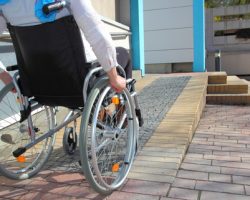How to Retrofit a Home for Handicap Accessibility
 How to Retrofit a Home for Handicap Accessibility
How to Retrofit a Home for Handicap Accessibility
As we get older, it’s important to think about making our homes more accessible for anyone who may have mobility limitations. Retrofitting a home for handicap accessibility doesn’t have to be a daunting task. Here are some tips on how to retrofit a home for handicap accessibility:
1. Install Ramps
The first step in retrofitting a home for handicap accessibility is to install ramps where necessary. Ramps provide a smooth, easy way for wheelchair users to move in and out of the home, and can also be helpful for anyone who has difficulty with stairs. When installing ramps, make sure that they are wide enough for a wheelchair and have secure handrails on both sides for safety.
2. Widen Doorways and Hallways
The next step is to widen doorways and hallways to allow for wheelchair access. A standard door is typically 30-32 inches wide, which may be too narrow for a wheelchair. Widening doorways and hallways to 36 inches or more can make a big difference in accessibility. In addition, consider replacing doors with pocket doors or barn doors, which take up less space and can be easier to maneuver through.
3. Install Grab Bars
Grab bars are an essential addition to any home that needs to be retrofitted for handicap accessibility. Installing grab bars in the bathroom and near stairs can make a big difference in safety and mobility. Make sure that grab bars are installed securely, and get in touch with a professional home builder if necessary to ensure that they are installed correctly.
4. Install Stairlifts
Stairlifts are a great way to make a multi-level home more accessible. A stairlift is a motorized chair that travels up and down a rail on the side of the stairs, allowing those with mobility limitations to easily move between floors. Stairlifts come in a variety of styles and can be custom-fit to your home’s staircase.
5. Modify Bathrooms
Bathrooms can be a challenging area for anyone with mobility limitations. To make your bathroom more accessible, consider installing a walk-in shower with built-in seating. Install hand-held shower heads that can be easily moved and adjust the height of the showerhead to allow for use by someone sitting down. Installing a raised toilet seat or a toilet with a built-in bidet can also be helpful.
6. Lower Countertops
Lowering countertops in the kitchen is an important modification for those in a wheelchair. Countertops that are too high can make it difficult to prepare meals and access kitchen appliances. Lowered countertops can make these tasks more manageable. Consider switching to a sink with an open space under it to make it easier for someone to transfer from their wheelchair.
7. Replace Doorknobs and Light Switches
Finally, replacing doorknobs and light switches with lever-style handles can make it easier for anyone with limited mobility to use them. Lever-style handles require less dexterity to use than traditional doorknobs and can be installed quickly and easily.
In Conclusion
Retrofitting a home for handicap accessibility doesn’t have to be overwhelming. With these tips, you can make your home more accessible, safe and comfortable for anyone with mobility limitations. Remember, it’s important to prioritize accessibility in your home, so that everyone can enjoy it equally.

 How to Retrofit a Home for Handicap Accessibility
How to Retrofit a Home for Handicap Accessibility



